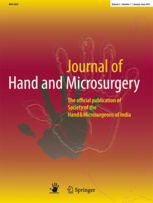
PHYSICAL THERAPY & REHAB
Extensor tendon injury: Early mobilization superior to immobilization at 12 weeks post-op
This report has been verified
by one or more authors of the
original publication.
J Hand Microsurg. 2012 Dec;4(2):65-73. doi: 10.1007/s12593-012-0075-x. Epub 2012 Sep 15.
5 prospective randomized or quasi-randomized controlled trials comparing static immobilization, dynamic splinting, and early active mobilization in the management of surgically-treated extensor tendon injuries were included in this review. The purpose of this systematic review and meta-analysis was to compare these three rehabilitation regimens with respect to total active motion (TAM). Results indicated that, when compared to static immobilization, early mobilization regimens (i.e. both dynamic splinting and early active motion) displayed significantly superior total active motion up to 12 weeks. However, the statistical significance of this difference may not be apparent after 12 weeks. No significant differences were found between TAM obtained with dynamic splinting and early active motion.
Unlock the full ACE Report
You have access to {0} free articles per month.Click below to unlock and view this {1}
Unlock NowCritical appraisals of the latest, high-impact randomized controlled trials and systematic reviews in orthopaedics
Access to OrthoEvidence podcast content, including collaborations with the Journal of Bone and Joint Surgery, interviews with internationally recognized surgeons, and roundtable discussions on orthopaedic news and topics
Subscription to The Pulse, a twice-weekly evidence-based newsletter designed to help you make better clinical decisions
Exclusive access to original content articles, including in-house systematic reviews, and articles on health research methods and hot orthopaedic topics
Or upgrade today and gain access to all OrthoEvidence content for just $1.99 per week.
Already have an account? Log in


Subscribe to "The Pulse"
Evidence-Based Orthopaedics direct to your inbox.
{0} of {1} free articles
Become an OrthoEvidence Premium Member. Expand your perspective with high-quality evidence.
Upgrade Now













































































